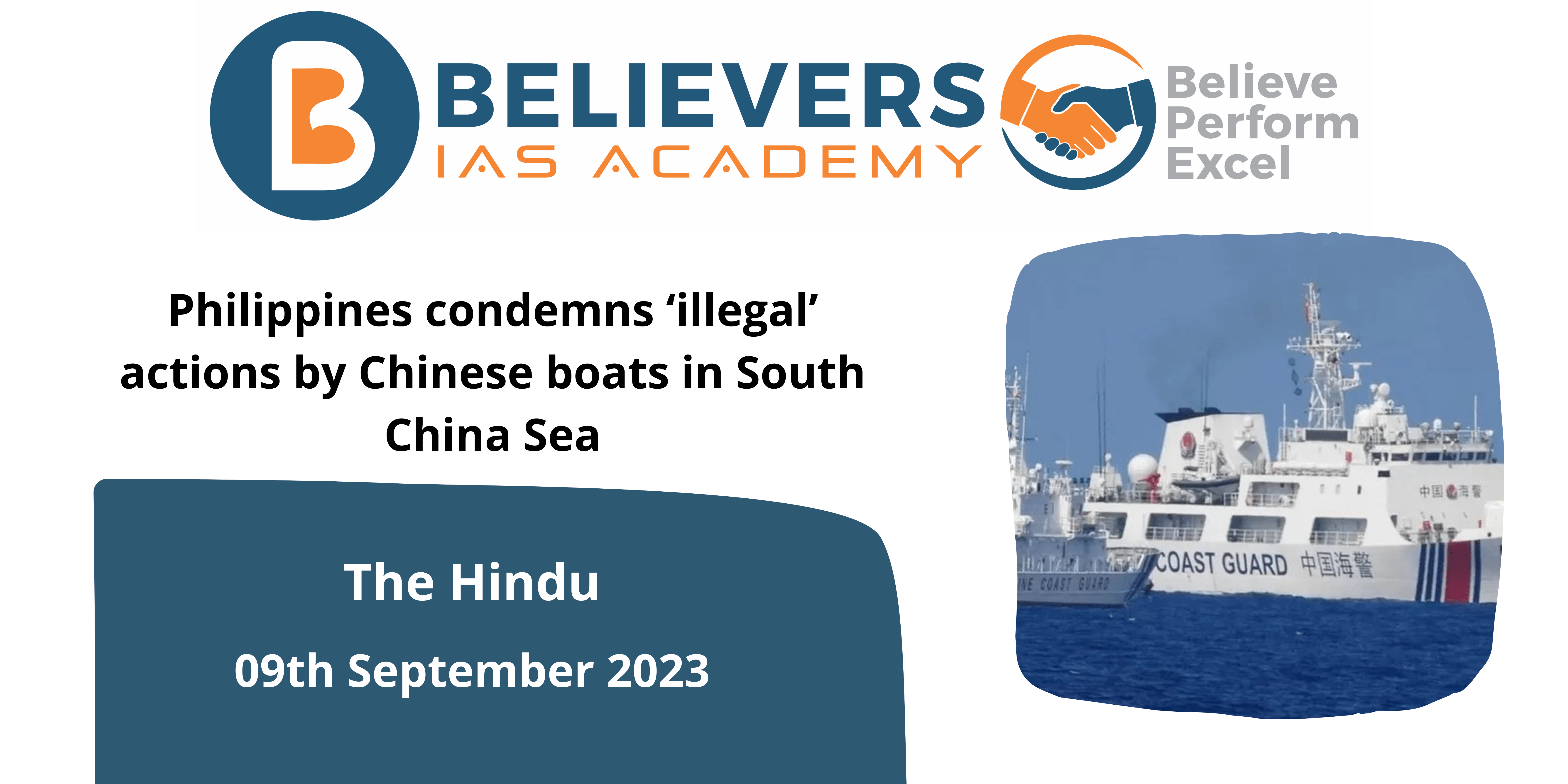Philippines condemns ‘illegal’ actions by Chinese boats in South China Sea
Context
After the boats allegedly interfered with another resupply operation to a distant military station in the contested South China Sea, the Philippines denounced the “illegal” conduct of the Chinese vessels on Friday.
What is the historical background behind the China-Philippines sea dispute?
- Ancient Claims: Chinese sovereignty claims date back centuries and include the Second Thomas Shoal (also called Ayungin in the Philippines), which is located in the South China Sea. These assertions are frequently supported by historical documents from long-gone Chinese dynasties like the Xia dynasty, which lasted for almost 4,000 years.
- Colonial Period: Spanish and the United States were just two of the European nations that ruled the Philippines throughout the colonial era. These colonial powers did not, however, make numerous claims to land in the South China Sea.
- World War II: The Philippines were held by Japan at this time, and there was a lot of naval activity in the area. Territorial issues and tensions in the region remain as a result of the war.
- Post-World War II Period: In 1946, the Philippines won independence from the US following World War II. More recent territorial conflicts in the South China Sea started during this time.
- 1950s and 1960s: In the 1950s and 1960s, China started claiming the Spratly Islands and the Paracel Islands as part of its territorial claims in the South China Sea. These territorial claims were supported by ancient documents and old maps.
- 1970s and 1980s: As several nations asserted their territorial claims in the South China Sea, including the Philippines, Vietnam, Malaysia, Taiwan, and Brunei, tensions grew. In 1974, China took over the Paracel Islands from Vietnam, and in 1995, it took over Mischief Reef from the Philippines.
- United Nations Convention on the Law of the Sea(UNCLOS): The 1982 adoption of the United Nations Convention on the Law of the Sea (UNCLOS) established guidelines and criteria for maritime borders and exclusive economic zones (EEZs). A framework for resolving territorial disputes by international law was created by the agreement.
- Arbitration and The Hague Ruling: The Philippines brought a complaint against China at the Permanent Court of Arbitration in The Hague in 2013, questioning the legitimacy of China’s “nine-dash line” and its actions in the South China Sea. The tribunal decided in favour of the Philippines in 2016, finding that China’s claims to the South China Sea were illegal under UNCLOS and that it had no “historic title” to the region.
- China’s Rejection of The Hague Decision: Despite the judgement, China rejected it and persisted in claiming sovereignty over the South China Sea. Additionally, other claimant nations kept up their regional operations.
Why has the Philippines grounded a warship on a reef?
- Territorial Claim: Both China and the Philippines have territorial claims to the Second Thomas Shoal, where the BRP Sierra Madre is berthed. The Philippines wants to stake a claim to the territory by mooring a warship there and demonstrating its presence and sovereignty.
- Deterrence: The presence of a grounded cruiser with a small number of Philippine soldiers acts as a deterrence to incursions by other claimant nations, particularly China. It sends a message that the Philippines is determined to defend its territorial claims and keep a military presence there.
- Value as a Symbol: The Philippines’ willingness to defend its interests in the South China Sea is symbolized by the grounding of the BRP Sierra Madre. It communicates that the Philippines will not give in to rival territorial claims and is prepared to utilize strategic assets to defend its position.
- Resupply Mission: The soldiers stationed on the grounded vessel depend on routine resupply trips to stay alive in this far-off place. The Philippine military’s presence on the shoal depends on these resupply trips, which also serve to show the nation’s commitment to upholding its territorial claims.
What steps did China take to prevent the supplies to Second Thomas Shoal?
- Chinese Coast Guard Interference: China’s Coast Guard vessels have frequently interfered in international affairs. Ships from the Chinese Coast Guard have regularly tried to obstruct or slow down supply runs from the Philippines to the BRP Sierra Madre. They have attempted to physically impede the supply boats, deployed water cannons, and participated in risky manoeuvres around them.
- Vessel Presence: Chinese naval vessels, including fishing boats and coast guard ships, have been stationed close to the Second Thomas Shoal. Many people see this presence as an effort to frighten or discourage Philippine resupply operations
- Shadowing: Chinese ships have reportedly followed Philippine ships, including supply boats, while they patrolled the waters near the Second Thomas Shoal. This persistent presence may lead to an uncomfortable or even deadly atmosphere.
- Warnings and Verbal Protests: China has warned and verbally protested to the Philippines to stop its activities near the Second Thomas Shoal and to recognize its sovereignty over the region.
- Legal and diplomatic pressure: China has regularly disregarded decisions made by international tribunals, such as the 2016 decision by the Permanent Court of Arbitration in The Hague that invalidated China’s South China Sea claims. Beijing has favoured bilateral consultations and negotiations and has used diplomatic pressure on nations like the Philippines to prevent the problem from going global.
What is the way forward from this situation?
- Negotiations and Diplomacy: The primary method of resolving the conflict should continue to be diplomacy. China and the Philippines are two of the parties concerned; they should communicate and negotiate to agree. It might also be possible to pursue multilateral negotiations with all claimant governments.
- Code of Conduct: A code of conduct (COC) for the South China Sea is being developed by China and the Association of Southeast Asian Nations (ASEAN). A successful COC that resolves important problems like sea rights and territorial disputes could help ease tensions and offer a framework for handling conflicts.
- Arbitration and Legal Mechanisms: As the Philippines did in its case against China in The Hague, nations may think about using international legal mechanisms, such as arbitration, to settle particular issues within the bounds of international law. However, it is important to promote adherence to arbitral decisions.
- Conflict Avoidance Measures: Putting conflict avoidance and confidence-building techniques into practice can help stop maritime accidents. This entails creating channels of communication between naval troops, creating rules of engagement, and working together on search and rescue missions.





